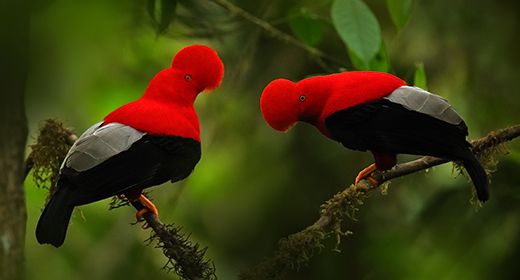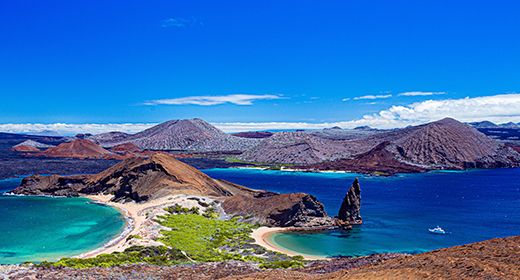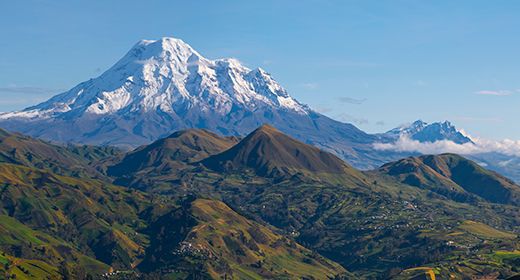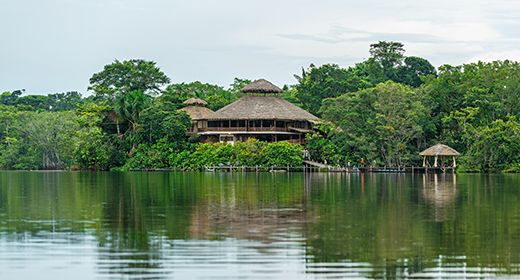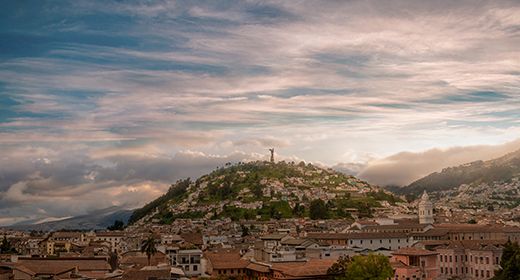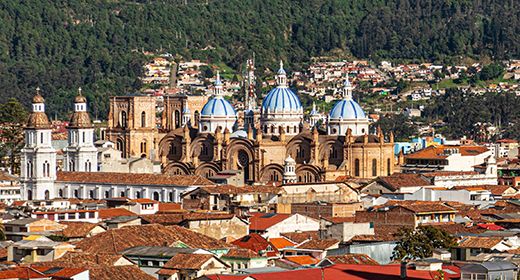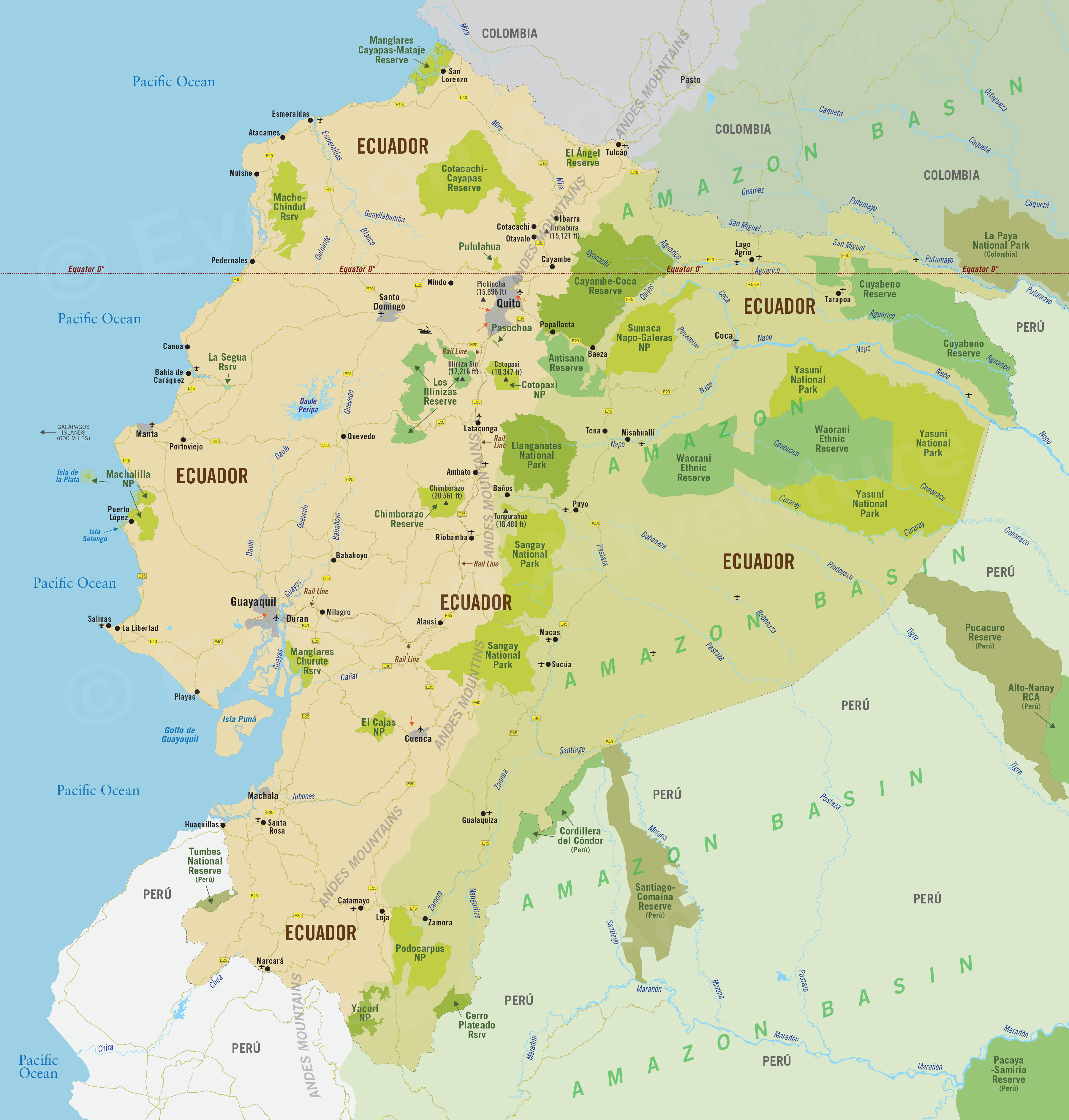Ecuador & Galápagos
Region Links: Galápagos Islands
Although small in size relative to other countries in South America, Ecuador's diversity of habitats and resultant astounding biodiversity make it one of the most popular destinations on the continent.
Ecuador offers an exceptional variety of experiences for visitors, including the Amazon Rainforest, 1 240 miles (2 000 kms) of Pacific Ocean coastline, the Andes Mountains, and the Galápagos Islands, which are located 560 miles (900 kms) offshore from the mainland.
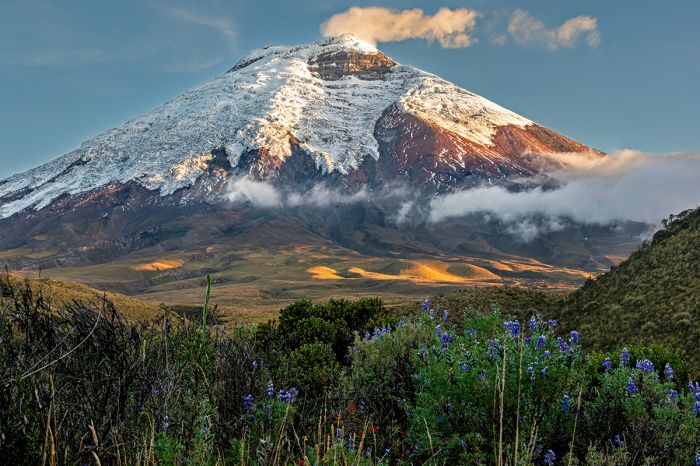
The north face of Cotopaxi volcano (19 347 feet/5 897 meters) with blooming Andean paramo vegetation in the foreground.
Straddling the Equator, Ecuador's mix of tropical rainforest, high-altitude Sierra, dry-climate coastal beaches, the the world-renowned Galápagos Archipelago make it a great choice for anyone looking for a diverse natural-world experience.
Ecuador's mainland geography can be described as three distinct regions: the Andes Mountains, which run north-to-south and roughly down the center of the country, the moist rainforest of the Amazon Basin to the east of the mountains, and the dry Pacific Ocean coastal region lying to the west of the mountains. Offshore from its mainland, the Galápagos Islands are also part of Ecuador.
For more information about the Galápagos Islands, visit the Galápagos Islands region page.
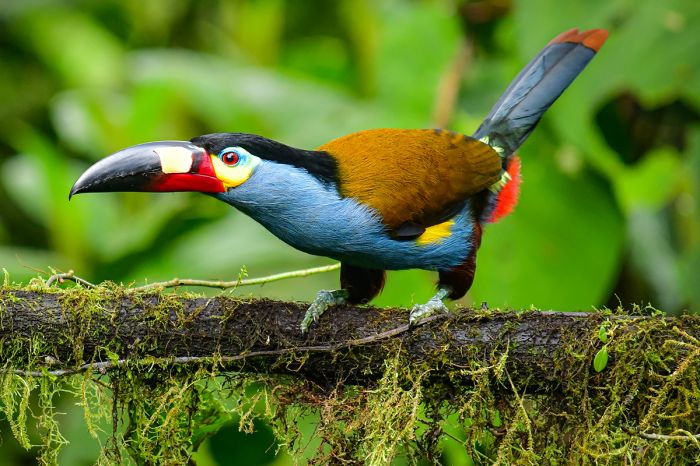
The plate-billed mountain-toucan (Andigena laminirostris) is found exclusively in Andean cloud forest in northwestern Ecuador and just into southern Columbia. This one was photographed near Mindo, Ecuador.
The Amazon
Around half of Ecuador is covered by the western portion of the Amazon rainforest, one of the world's greatest tropical jungles. The Amazon covers roughly 2.7 million square miles, the majority of which is in Brazil (58.4%), but it also extends west into Peru (12.8%), Bolivia (7.7%), Columbia (7.1%), Venezuela (6.1%), Guyana (3.1%), Suriname (2.5%), French Guiana (1.3%) and Ecuador (1%).
The jungle is home to an estimated 350 native ethnic groups and is the largest and most biodiverse tract of tropical rainforest in the world. Large-scale deforestation threatens this magnificent gem of biodiversity.
The Amazon is a must-see for nature lovers and Ecuador has a good number of jungle-based lodges that offer opportunities to see some of its wildlife, including jaguars, caimans, tapirs, capybaras, giant anteaters, otters, huge anacondas, sloths, and an abundance of primates. Birding in the Ecuadorian Amazon is outstanding and almost any lodge or camp offers expert birding guides.
Visitors will also likely see indigenous people that live in small villages along the waterways and still survive in traditional ways by hunting and fishing.
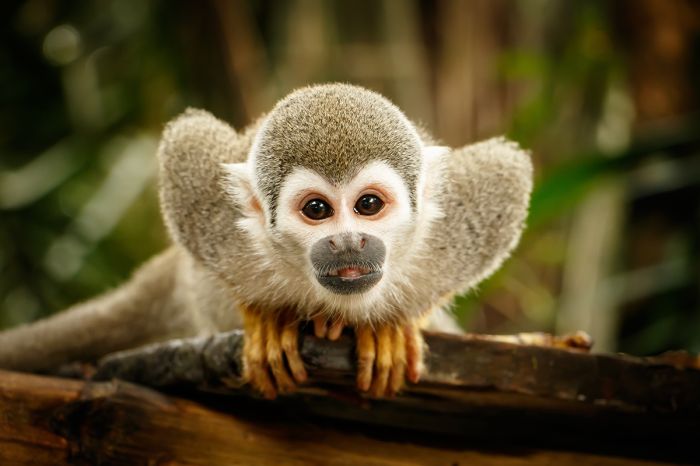
An Ecuadorian squirrel monkey (Saimiri cassiquiarensis macrodon) in Ecuador's Amazon rainforest.
Most of the tourism in Ecuador's Amazon occurs in the northern portion, with most tours starting from the bustling outpost town of Coca, followed by a boat transfer downstream to the east along the Napo River (a tributary of the Amazon River), where a selection of excellent jungle lodges are located. There are also some very good Amazon lodges further south, also along the Napo River between Coca and the town of Puyo.
The primary rainforest tracts along the Napo River are sparsely populated by indigenous people, with only occasional homesteads. The Napo River is the region's only real mode of transportation and the myriad tributaries and backwaters form the basic infrastructure for the remotely-located indigenous communities that still exist here.
Yasuní NP
Offering the finest jungle experiences in Ecuador, Yasuní National Park covers 3 860 square miles (10 000 sq kms) of primary rainforest situated between the Napo River in the north and the Curaray River in the south. The park is bordered on the west by the Waorani Ethnic Reserve and stretches east all the way to the Peruvian border.
The Yasuní is arguably the most biodiverse place on the planet, with 600 species of bird recorded, 500+ species of fish, 150 species of amphibian and over 100 000 known species of insect (roughly the same number as is found in all of North America).
The park contains roughly 50% of Ecuador's mammalian species, including jaguar, ocelot, tapir, a dozen species of primate, over 80 species of bat, as well as aquatic mammals, including the pink river dolphin, giant otter, and manatee.
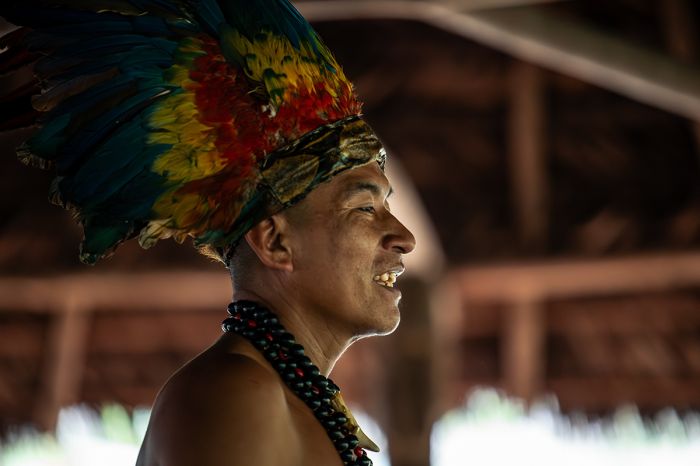
An indigenous Waorani man wearing a traditional headdress in Ecuador's Amazon jungle.
Although Yasuní is a national park, the majority of its land is mostly inaccessible and still relatively unexplored. There are three Waorani ethnic groups living in the deep jungles of the park and they have little to no contact with the outside world.
In order to help protect the land from eager oil exploration companies, Yasuní was declared a national park in 1977, and two years later, was declared an UNESCO Biosphere Reserve. Despite these official protections, Yasuní and its indigenous tribes are under constant threat from the oil industry, which has built access roads into the park.
In terms of Ecuador's Amazonia, over half of its land is officially protected; however, oil-mining threatens to change the pristine nature and size of this amazing ecosystem. Traveling to Ecuador's Amazon certainly aids in swaying the decision-makers towards conservation and sustainable use rather than exploitation.
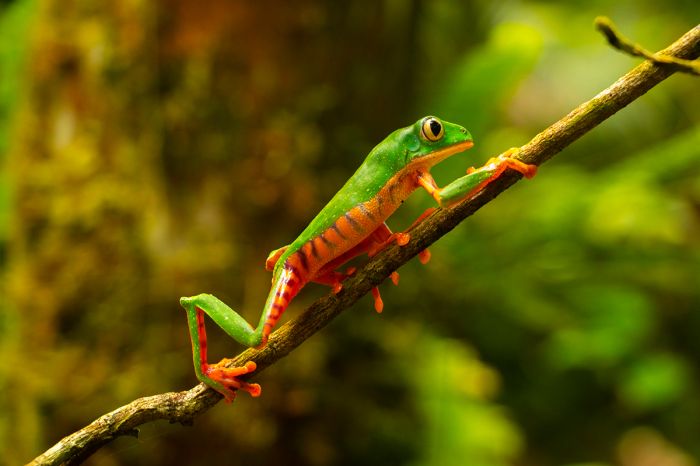
A tiger-striped tree frog (Callimedusa tomopterna) in Ecuador's Yasuní National Park.
Andes Mountains
The Andes Mountains are the longest continental mountain range in the world, forming a continuous highland along the western edge of South America. The range is 5 530 miles (8 900 kilometers) long and has an average height of about 13 000 feet (4 000 meters). The Andes stretch from south to north through seven South American countries: Argentina, Chile, Bolivia, Peru, Ecuador, Colombia, and Venezuela.
The Andes can be divided into three geographic sections: the Northern Andes in Venezuela, Colombia, and Ecuador, the Central Andes in Peru and Bolivia, and the Southern Andes in Argentina and Chile.
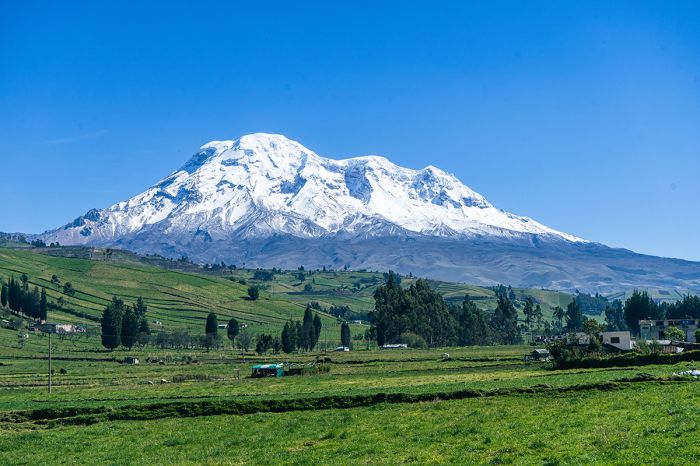
Chimborazo (20 561 feet/6 267 meters) is Ecuador's highest peak.
The Andes are the highest mountain range outside of Asia. The highest peak in the Andes is Argentina's Aconcagua, which rises to an elevation of 22,838 feet (6,961 meters). The Andes also contains the highest volcanoes on Earth, including Ojos del Salado on the Chile-Argentina border, which rises to 22,615 feet (6,893 meters).
The Ecuadorian section of The Andes is replete with many volcanos, some of which are still active. The country's well-known and much-visited 'Avenue of the Volcanos' is a 200-mile long stretch located 2-hours drive south of Quito that contains numerous volcanic peaks, protected areas, small indigenous villages, archeological sites, snow-capped peaks, lush, green valleys, and mountain lakes.
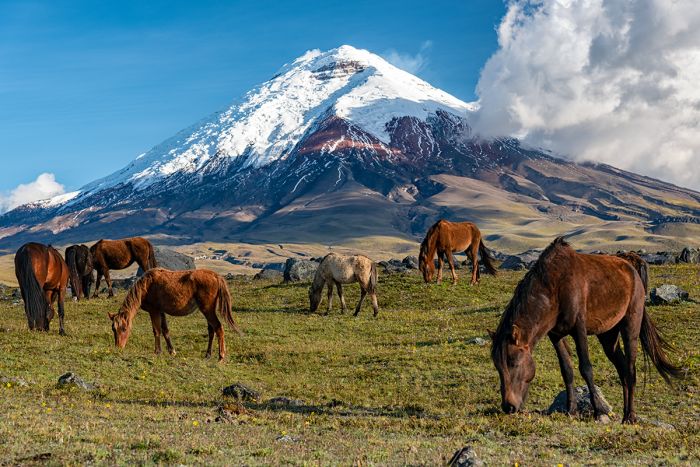
Wild horses in Cotopaxi National Park. Cotopaxi (19 347 feet/5 897 meters) is the world's tallest active volcano.
Some of the notable peaks in Ecuador (all of them are volcanos), sorted by elevation:
- Chimborazo (20 561 feet/6 267 meters): an inactive volcano and the furthest point from the Earth's center.
- Cotopaxi (19 347 feet/5 897 meters): the tallest active volcano in the world.
- Illinizas: Illiniza Sur (17 218 feet/5 248 meters) and Illiniza Norte (16 818 feet/5 126 meters) are twin, inactive, glacier-covered peaks separated by a saddle only 1 km long.
- Tungurahua (16 480 feet/5 023 meters): an active volcano in eruption since 1998 near Baños-Tunguragua.
- Pichincha (15 696 feet/4 784 meters): an active volcano overlooking the capital city of Quito (last erupted in 1999, covering the city in several inches of ash).
- Imbabura (15 121 feet/4 609 meters): an inactive volcano (has not erupted for 7 500 years), but is not believed to be extinct.
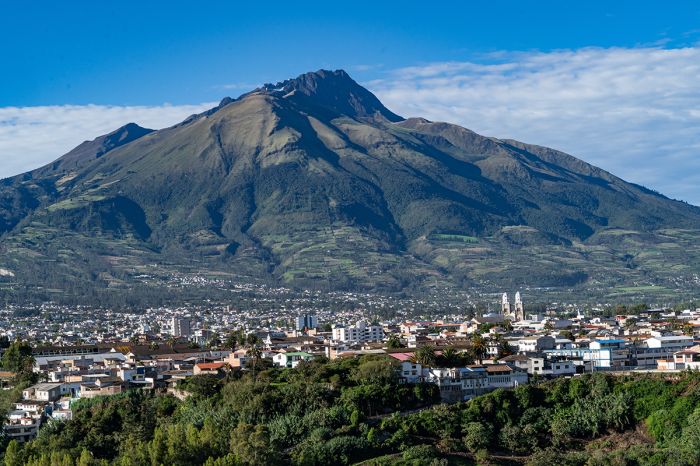
Imbabura volcano (15 121 feet/4 609 meters) rises above the city of Ibarra in Ecuador's northern Andes.
Quito
The capital city of Quito (officially San Francisco de Quito) is Ecuador's second-most populous city, with around 1.4 million inhabitants. The city is situated at an elevation of 9 350 feet (2 850 m) on the eastern slopes of Pichincha, an active stratovolcano, making it the second-highest capital city in the world (after La Paz, Bolivia).
The area around the city was once inhabited by an indigenous people known as the 'Quitu' before they were conquered by the Inca in the early 1500's. Present-day Quito was founded by the Spanish, who conquered the Inca there in 1534. The city offers superb culture and history and was declared an UNESCO World Heritage Site in 1978 and is considered the best-preserved colonial city in Latin America.
Quito offers a dazzling blend of colonial architecture, bustling streets and historic plazas, green parks, churches and monasteries, art galleries, museums, modern shopping malls and boutiques, colorful markets, vibrant nightlife, and a diverse selection of visitor accommodations and restaurants.
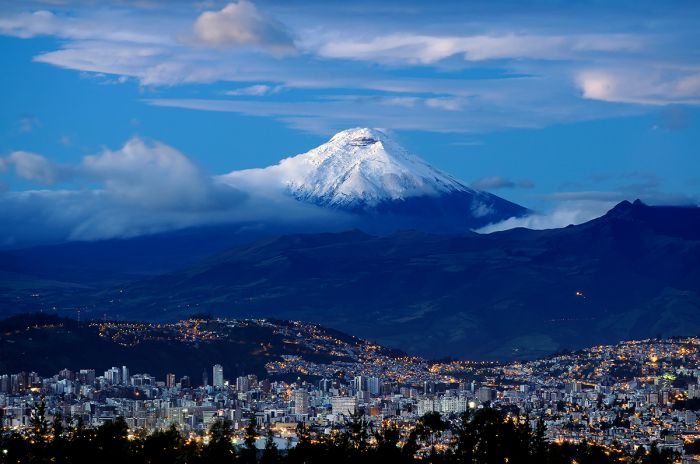
Quito city with Cotopaxi Volcano (elevation: 19,347 feet) in the distance.
Guayaquil
Located on the western bank of the Guavas River at the Gulf of Guayaquil is Ecuador's most populous city, Guayaquil (officially Santiago de Guayaquil), with around 2 million residents. The city was founded by the Spanish in 1538 and remains one of the most important port cities in South America.
The most pleasant place to walk in Guayaquil is the riverfront boardwalk called Malecón 2000, which connects some of the city's monuments. The Malecón features an expansive, paved esplanade with botanical gardens, architecture, sculptures, shopping, and restaurants. The walk is safe, as it is only accessible via guarded entrance gates and is patrolled by security personnel.
At the north end of the Malecón is the historic neighborhood of Las Peñas, the oldest in Guayaquil and one of the prettiest as well, with cobblestone alleys and beautifully restored, colorful wooden houses.
Guayaquil offers a good selection of visitor accommodations, dining establishments, and a lively nightlife.
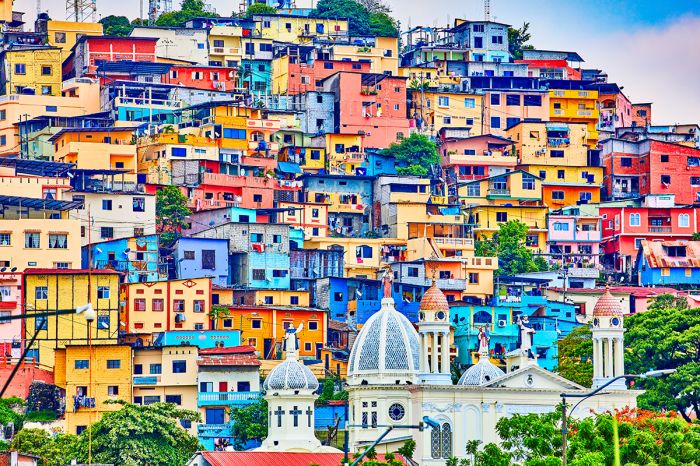
Colorful houses in the historic Las Peñas neighborhood of Guayaquil, Ecuador.
Cuenca
The city of Cuenca (officially Santa Ana de los Cuatro Ríos de Cuenca) is best known for its colonial architecture and cultural diversity. Cuenca was founded by the Spanish in 1557 after they conquered the Inca city of Tomebamba, which was located there and is said to have rivaled Cusco in terms of its splendor.
Cuenca is Ecuador's third most-populous city (~300 000 residents), but is small compared to Quito and Guayaquil. The city is located in the Andes Mountains (elevation 8 400 feet/2 560 meters) 80 miles (125 kms) southeast of Guayaquil.
The city's Colonial Centre is a must-visit with its narrow, cobbled streets, lovely colonial architecture, balconied houses with interior courtyards, plus numerous churches and monasteries. The Colonial Centre (Centro Histórico) is an UNESCO World Heritage Site. There are plenty of options for accommodation, plus a diversity of restaurants, bars, and shopping.
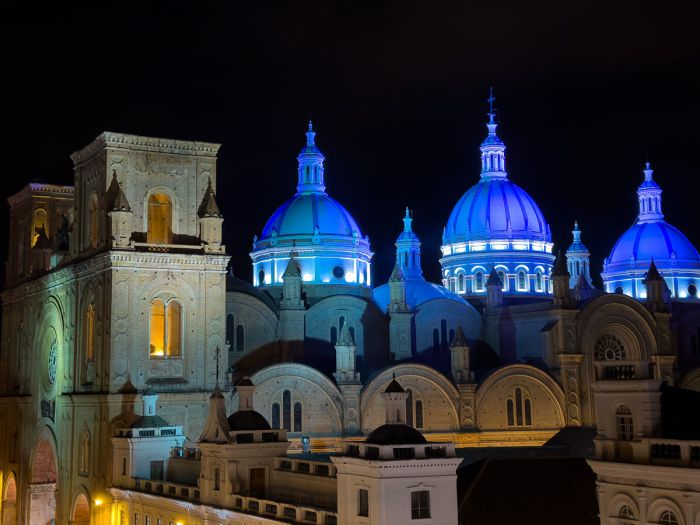
The Cathedral of the Immaculate Conception in Cuenca, Ecuador.
Galápagos
The Galápagos Islands are an archipelago of volcanic islands located 560 miles (900 kms) west of mainland South America and distributed across 17 375 square miles (45 000 sq kms) of ocean. The archipelago has been a province of the Republic of Ecuador since it claimed sovereignty over the 13 large islands and over 100 small islands in 1832.
The Galápagos first became known to the world after Charles Darwin visited the islands during a five-year British global expedition aboard the HMS Beagle starting in December 1831. The expedition's purpose was to chart the coast of South America. Darwin served as the expedition's naturalist and the Beagle arrived at the Galápagos on 15 September 1835.
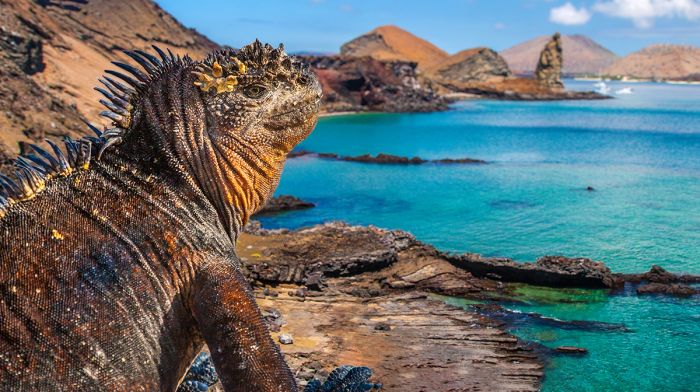
The Galápagos marine iguana (Amblyrhynchus cristatus) is one of many endemic species that can be seen on a visit to the islands.
Darwin spent five weeks collecting samples and was amazed at the tameness of the wildlife, which had no innate fear of humans. Upon his return to England Darwin began detailed investigations of his samples from the islands (in particular, his study of the various finch birds that inhabit the islands) and, in 1838, devised his theory of natural selection. Darwin published his theory of evolution with compelling evidence in his 1859 book On the Origin of Species.
Today, the Galápagos is one of the world's top wildlife destinations, with tourists mainly staying aboard ocean-going vessels that cruise the waters and stopping over at designated land-based and water-based sites, making day trips to the islands and moving to new sites midday and overnight. There are also a very limited number of island-based overnight accommodations.
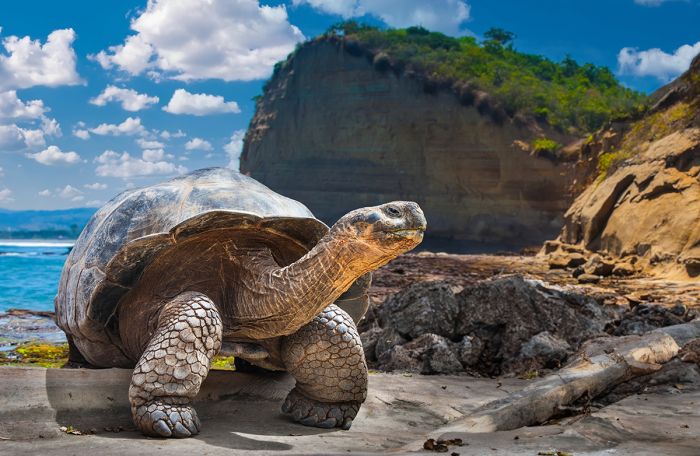
The Galápagos giant tortoise (Chelonoidis niger) can be seen on several of the Galápagos Islands.
Activities offered in the Galápagos include various water-based excursions, including snorkeling (and diving) with penguins, seals, myriad fishes, sharks, sea turtles, marine iguanas, and rays. The water temperatures are pleasantly warm, but wet suits are typically provided on all boats.
Galápagos cruises typically include two land-based activities per day at different islands (or separate locations on the larger islands), one in the morning and another in the afternoon. Inflatable zodiacs are used for the water transfers between your boat and the islands.
Most land activities involve a wet (shallow water, so wet only up to your knees) or beach landing, followed by walking with a naturalist, who will impart detailed information on the island's geology, history, and wildlife.
For more information about the Galápagos Islands, visit the Galápagos Islands page.
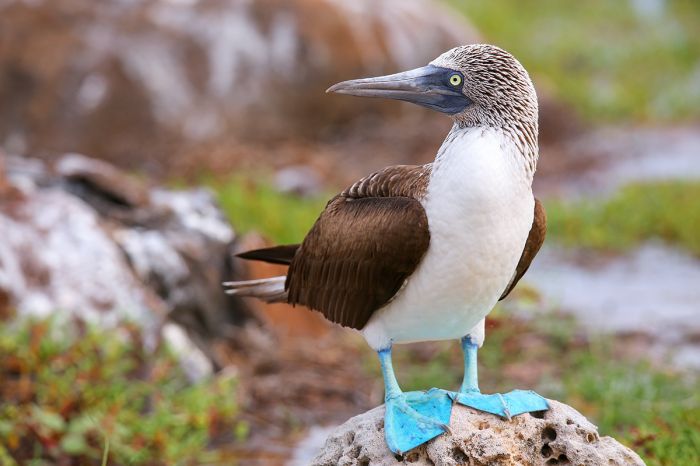
The blue-footed booby (Sula nebouxii) is one of the most popular species amongst tourists to the Galápagos.




